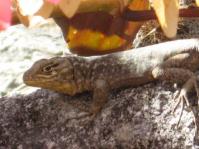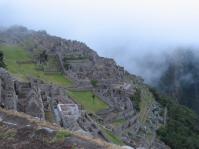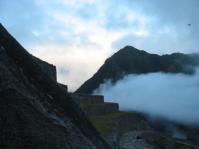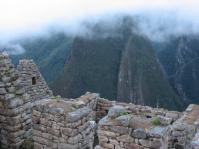Profile
Blog
Photos
Videos
I´ve been in the internet cafe all morning and only managed to upload half the photos I tried to, but there are 2 new albums.
After all the problems with the chest infection and altitude sickness, I changed my plans and went to the Manu rainforest on Sunday 5th July, and got back yesterday evening. There were 6 of us in the group - a Dutch couple (he was 79, she was 56), 2 American sisters in their early 20´s, a Korean/Canadian girl and me, with an English guide called Tina, a cook, boatman and assistant boatman. The journey over the Andes to reach the cloudforest, where we spent the first night, was amazing. The landscape changed constantly as we went round hairpin bends and the sun rose (we set off from Cusco at 6 a.m.). In the first 3 hours we had stopped in a village famous for its bread (all the villagers have clay ovens and supply bread to Cusco), learned about various birds and trees, and visited the ruins of a pre-Inca city, built about 1500 years ago. Most of the remains are burial chambers. We stopped for breakfast at 10 at Paucartambo, where there is an Inca bridge, and reached the puna, a landscape with long grasses in which wild guinea pigs live, and a few stunted trees, by lunchtime. Then down through the elfin forest to the cloudforest, where we spent the night in a very comfortable lodge. We hoped to see the " c*** of the rock" birds performing their dawn and dusk display, but missed it by half an hour. I was fascinated by all the ferns that are everywhere here.
On Monday morning we continued by bus for several hours down to the river Alto Madre de Dios, where we were to transfer to our motorised canoe. When the road (such as it is) arrived, the valley became rich as valuable timber was cut and exported, but once the trees had all gone it became farmland, which was eventually given by the government to small farmers. We passed a number of very poor small settlements where the people live in tiny wooden huts (but they have TV!), with a few hens and turkeys.
We joined the boat at Atalaya and travelled for a few more hours to our first rainforest lodge. After my initial qualms, having been told that the boat would be negotiating white water - which it didn´t - I settled down and enjoyed the scenery and the guide pointed out water birds, birds of prey etc etc.
Throughout the week in the jungle we spent a lot of time on the water - the Alto Made de Dios and Manu rivers, and three lakes, and walking on trails in the jungle. We were up at 5 most days, because that´s when the wildlife is at its busiest. We watched 6 species of monkeys - squirrel, 2 types of capuchin, spider, woolly and red howler. I liked the woolly monkeys because they were the most agile and entertaining, but the howler monkeys were easy to watch because they don´t move around much. They eat leaves, which takes hours to digest, and they sit around while this happens. They don´t actually howl, their call is like roaring wind (probably due to digestive problems!). One afternoon we went out on a raft on Lake Salvador to see where the giant otters were going to sleep that evening, so that we´d know where to look the next morning. We drifted past one of their toilet sites, which reeked of fish. We stayed on the lake as the sunset, the moon rose and the stars came out, while big bats with almost transparent wings flitted around us. As we went back to the boathouse, little proboscis bats that roost under the boathouse also came out to hunt. In the morning we saw 6 giant otters and watched them playing and eating fish (very noisily!). I only have one photo of an otter, as they were a long way off and I don´t have a long lens.
Another morning we went by boat to a blind opposite a clay lick to watch parrots and macaws. Hundreds of blue-headed parrots arrived and sat in the trees like big green leaves and blue flowers. They were very nervous and often took off together, circling around before they felt safe enough to return to the trees. Red and green macaws arrived in pairs and sat higher in the trees. They are big enough that birds of prey are not a problem for them, and they tend to keep watch for the parrots. After a couple of hours the parrots disappeared without going down to the bank to eat the clay (which gets rid of toxins they ingest when they eat unripe fruit), but a bit later the macaws gradually moved down to the clay, and it was a beautiful sight.
We also saw macaws at their nests in hollow tree trunks - one morning 2 red heads were peeping out of a tree, and 2 scarlet macaws emerged. They are a stunning colour. Another time we watched a pair of chestnut-fronted macaws working on their nest, chiselling out a bigger hole, with bits of wood flying around.
My other favourite birds were oropendulas, which have long tails with bright yellow flashes that show when they fly. Their long nests hang in trees in open areas where they are safe from monkeys. Their call sounds like something plopping musically into water. On the river beaches I liked the black skimmers, whose lower beaks are bigger than the upper part. They fly low over the water and scoop it into their beaks as they fly. They are often seen with pied lapwings, which are dainty, jolly-looking birds.We saw just one pygmy kingfisher, which was very beautiful. We watched a snakebird, which looks a little like a cormorant, sitting on a branch. It gets its name because it has a very long thin neck and a long pointed head, so it looks like a snake. Although they catch fish, their feathers are not waterproof, so they spend a long time drying out after a meal. The bird we watched somehow managed to fall off its branch into the water, which we all thought was hysterical, but it looked quite annoyed when it surfaced! There are lots of hawks and falcons along the rivers, some quite big, but I was taken with the little bat falcons, so-called because they flutter around like bats. I was amused by hoatzins, which are rougjly the size of a chicken and don´t fly well, though they spend their time in small trees and bushes. They have tails rather like turkeys and display a lot. Their call sounds like heavy breathing, it´s most odd. There are usually vultures of various sorts circling around looking for dead things to eat. Another bird I liked was the pale winged trumpeter, a big black and white bird with long legs that ambles through the forest eating seeds. They are very gentle and people sometimes keep them as pets.
In the forset there is a constant tinnitus of crickets (unless it´s raining, which it did quite often while we were there). There are also dazzling butterflies and moths - vivid oranges, metallic blues and greens etc. I also saw a clearwing butterfly, with leaded-glass wings, that only feeds on plants of the nightshade family. The best place to see butterflies is on the river banks, and there were foten several around the boat as we set off. There are ants of all shapes and sizes - I watched leafcutter ants carrying big pieces of leaf to feed the fungus on which they themselves feed, and marching columns of army ants that devour anything in their path. Their jaws are so strong that they are sometimes used to suture wounds. I found a couple of bullet ants, that live in very small colonies. They are about an inch long and have a very painful poisonous bite. There are ant nests haning in trees, made from soft chewed wood, and others attached to trunks. We found the nest of a type of tiny wasp that lives in treetrunks. They make the nest safe by creating a funnel entrance that is guarded by some of the colony.
We saw some interesting spiders including tarantulas (pink-footed, if you look closely enough!), web-throwing spiders that sit and wait with "fishing nets" to cast over their prey), and socail spiders that make a big communal web - an arachnid co-operative. Fisrt to the trapped prey gets to eat it.
We heard a lot of frogs but didn´t see very many, athough I found one sitting on the wash basin one night. Not quite as pretty as the opossum on a basin the previous evening, which leapt away when I told it I was going to get the camera!
I enjoyed seeing turtles sitting on logs at the edge of the river; they control their body temperature by alternately swimming and sunbathing. Sometimes when they are sitting on logs butterflies come to drink from their eyes, to get minerals. But I wasn´t especially excited by the caiman we sometimes saw on the beaches, they´re not very attractive. On the evening we spent on the lake, we searched for caiman with our flashlights - their eyes reflect orange light. When we were travelling upstream one day, we saw a big yellow-footed tortoise swimming downstream past a little village where we´d stopped to refuel the bboat. The boatman scooped it up and we took it to the lodge, where it was released and wandered off into the forest. Tina said the villagers would otherwise have caught and cooked it.
I loved some of the trees. Kapok and fig trees have huge buttress roots. The trunk can be 15 feet across at the base, with enormous roots snaking off across the forest floor. The kapok trees also have lovely pink flowers at this time of year - you can´t see them looking up into the tree as it´s too tall, but they look beautiful from the river. Many trees are colonised by epiphytic plants such as philodendron, which we have as houseplants, and are surrounded by curtains of their roots. The naked tree sheds its bark every year to get rid of hangers-on, and is smooth and rusty brown, in contrast to most of the other trees, which have white or grey trunks. Along the river banks in the rainforest and everywhere in the cloudforest, there are parrots beak vines, covered with bright red or orange floweres shaped just like the birds´ bills, and quite rigid.
This is supposed to be the dry season, but we had rain at some time most days. We welcomed it when we were on the lake on a very hot afternoon, as it cooled us down and left a beautiful soft light and a double rainbow. It deluged throughout the last night and in the morning the river was flooded and fallen trees were crashing into our boats where they were moored (very bizarre, as the previous day the water had been so low that nerly everyone had to get out and push the boat off the bottom at one point). I was quite sacred at the prospect of having to travel on the swollen river - it was the only time I´ve resorted to Rescue Remedy since I´ve been away), but it (and I) had calmed down a lot by the time we left.
Yesterday we went back to the c*** of the rock lek at daybreak, and this time the birds obliged - maybe a dozen bright red and black male birds squawking at the tops of their voices to attract the females - they really went for it when the first female arrived!
It was a brilliant 9 days and I enjoyed nearly every minute of it, apart from the horrendous sandfly bites and the leaking left wellie (we were issued with these when we arrived at the river) which meant I was walking around in my own personal quagmire.
I´m just in Cusco for 2 nights- thankfully, as I´m struggling with the altitude again - then I go to Machu Picchu. On Friday I´m flying via Lima to the northern coast and desert, so I´ll write again from there, and maybe I´ll be able to upload the rest of the jungle photos!
- comments










